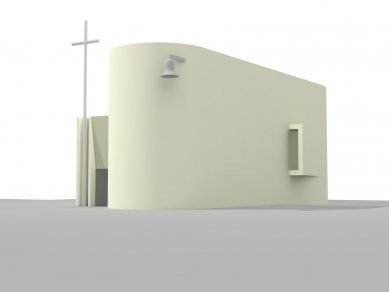
In Těrlicko, a spiritual center will be built
Těrlicko had its church from 1772 until 1962. At that time, it was demolished to make way for a water reservoir. During that period, the center of Těrlicko was built in the spirit of late socialist realism.
Multiple attempts were made to construct a new church starting in 1968. Over time, the opinion naturally prevailed to build rather a spiritual center that would serve not only the faithful but also the youth, charity, musicians, and broader civic activities. A location in the center of the village was logically chosen for it. The parish acquired the land in the center twenty years ago, and later the site was included in the zoning plan for this purpose. The municipality should now have dignified spaces for gathering after many decades. After twenty years of considering proposals from many architects, the project of Atelier Štěpán was selected.
However, the project has also awakened emotions among people who disagree with such an intention. This is more about disagreement with the intention rather than with the project itself. But it is now difficult to speculate about their motivations.
A significant amount of time was devoted to searching for the resulting urbanistic composition of the building. Various shapes, sizes, and height variants were examined, and after a longer search, the optimal code for this site was found. The only possibility is to create a symbiosis of buildings in the given environment. In height, the mass of the building is similarly tall as the higher part of the cultural house. The building responds to the given space with its orientation, height, and expanding footprint. The footprint and sectional proportions of the building stem from historically verified realities of sacred buildings and classical proportions.
The parish aims to obtain both the zoning decision and the building permit this year. Opponents, however, plan to file objections against each step. Thus, we will live with architectural hope in the common sense of civil society.
Multiple attempts were made to construct a new church starting in 1968. Over time, the opinion naturally prevailed to build rather a spiritual center that would serve not only the faithful but also the youth, charity, musicians, and broader civic activities. A location in the center of the village was logically chosen for it. The parish acquired the land in the center twenty years ago, and later the site was included in the zoning plan for this purpose. The municipality should now have dignified spaces for gathering after many decades. After twenty years of considering proposals from many architects, the project of Atelier Štěpán was selected.
However, the project has also awakened emotions among people who disagree with such an intention. This is more about disagreement with the intention rather than with the project itself. But it is now difficult to speculate about their motivations.
A significant amount of time was devoted to searching for the resulting urbanistic composition of the building. Various shapes, sizes, and height variants were examined, and after a longer search, the optimal code for this site was found. The only possibility is to create a symbiosis of buildings in the given environment. In height, the mass of the building is similarly tall as the higher part of the cultural house. The building responds to the given space with its orientation, height, and expanding footprint. The footprint and sectional proportions of the building stem from historically verified realities of sacred buildings and classical proportions.
The parish aims to obtain both the zoning decision and the building permit this year. Opponents, however, plan to file objections against each step. Thus, we will live with architectural hope in the common sense of civil society.
The English translation is powered by AI tool. Switch to Czech to view the original text source.



0 comments
add comment









